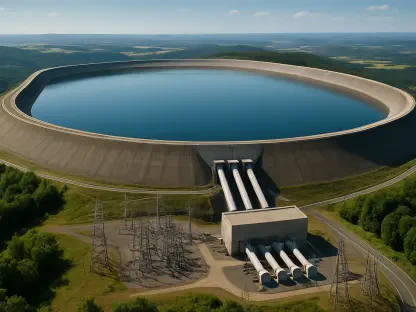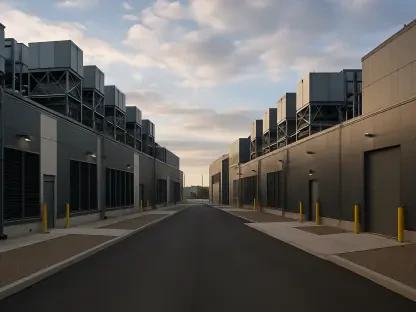Ontario’s electricity grid is witnessing a notable shift towards increased reliance on gas-fired power generation, a trend that harkens back to an era when coal played a significant role in the province’s energy landscape. According to the Independent Electricity System Operator (IESO), gas-fired generation now accounts for 16% of Ontario’s electricity production. This increase in gas usage has contributed to a reduction in emissions-free electricity, which currently stands at 84%, down from 87% in the previous year and from a peak of 96% in 2017. This represents the highest percentage of emitting power since 2012, when coal-fired plants were operational. The heightened dependence on gas-fired electricity has sparked concern among environmental advocates and policymakers as Ontario navigates its energy future. The shift back to gas underscores a complex interplay of factors influencing the grid, prominently including nuclear refurbishments and reduced imports, which have collectively driven the province towards greater gas reliance. This development highlights the challenges faced in balancing the demands for energy stability, economic competitiveness, and environmental integrity.
The Role of Nuclear Refurbishments and Imports
The increase in gas-generated electricity in Ontario can be primarily attributed to two pivotal factors: ongoing nuclear refurbishments and the reduction of electricity imports. Nuclear power remains Ontario’s backbone, responsible for 51% of the province’s electricity generation this year, with hydroelectric power contributing approximately 24%. However, as nuclear units undergo critical refurbishments to extend their operational life, gas-fired plants emerge as necessary alternatives, providing crucial flexibility and stability to the grid. Despite their higher emissions profile, these gas plants bridge the energy gap created during nuclear outages. The IESO has highlighted this necessity, pointing to substantial outages from nuclear refurbishments and a decrease in import supplies as catalysts for increased gas generation. With nuclear installations adapting to new demands, the reliance on gas serves as a strategic response to safeguard the province’s energy security during transitional periods. This strategy maintains the balance within the grid, albeit raising questions about its long-term environmental commitments and prompting calls for greater investments in renewable sources.
The Political and Environmental Dynamics
Environmental advocates argue that Ontario’s increased dependence on gas-fired power could have been mitigated by prior strategic energy planning, particularly with respect to renewable energy and advanced battery storage systems. Critics point to the decision made by Premier Doug Ford’s government in 2018 to terminate 750 renewable energy contracts formed during the previous Liberal administration. These contracts were deemed economically untenable due to above-market rates, but opponents argue that dismissing them was shortsighted, given their potential impact on Ontario’s energy mix today. The shift in the province’s procurement strategy for new electricity generation options—from initially focusing on non-emitting sources to adopting a “technology agnostic” approach—has sparked criticism. This move, made under Energy Minister Stephen Lecce, is perceived as opening avenues for heightened reliance on gas. Lecce, however, has publicly projected that refurbishing existing nuclear units will result in a cleaner grid with nearly 99% non-emitting sources by the end of the decade, framing the current dependence on gas as a predictable outcome of strategic renovations.
Economic Implications and Future Prospects
Political repercussions and economic impacts are significant dimensions of Ontario’s evolving energy narrative. Green Party Leader Mike Schreiner has expressed concern over Ontario’s grid losing some of its appeal as a destination for global investments due to the decrease in emissions-free power generation. He contends that Ontario’s competitiveness in retaining global capital investment hinges on maintaining a clean grid, implying that recent policy decisions may undercut future economic prospects. The commitment to refurbishing nuclear units is seen by some as a gamble, trading short-term emissions for long-term benefits as nuclear fleets rejoin the grid. Despite concerns about current emissions, some optimism exists regarding Ontario’s ambitious plans for energy innovations. Among these plans is a $21-billion initiative to deploy four small modular reactors designed to power approximately 1.2 million homes. This project stands as a symbol of resilience and future energy security. Nonetheless, debates persist around cost efficiency. Critics like Stephen Thomas from the David Suzuki Foundation have cautioned against potential high operational expenses of modular reactors and advocate for more focus on renewable alternatives, which are on a trajectory of decreasing costs.
A Multifaceted Energy Landscape
Ontario’s electricity grid is experiencing a significant shift, with an increased reliance on gas-fired power generation. This trend echoes a previous era when coal played a major role in the province’s energy supply. The Independent Electricity System Operator (IESO) reports that gas-fired generation now constitutes 16% of Ontario’s electricity output. The rise in gas usage has led to a decline in emissions-free electricity, currently at 84%, down from 87% last year and a peak of 96% in 2017. This is the highest percentage of emitting power since 2012, when coal-fired plants were still operational. Environmental advocates and policymakers have voiced concerns about this increased dependence on gas as Ontario plans its energy future. The deeper reliance on gas is influenced by factors such as nuclear refurbishments and decreased imports, steering the province towards more gas usage. This situation underscores the challenge of balancing energy stability, economic competitiveness, and environmental goals in Ontario’s evolving energy landscape.









